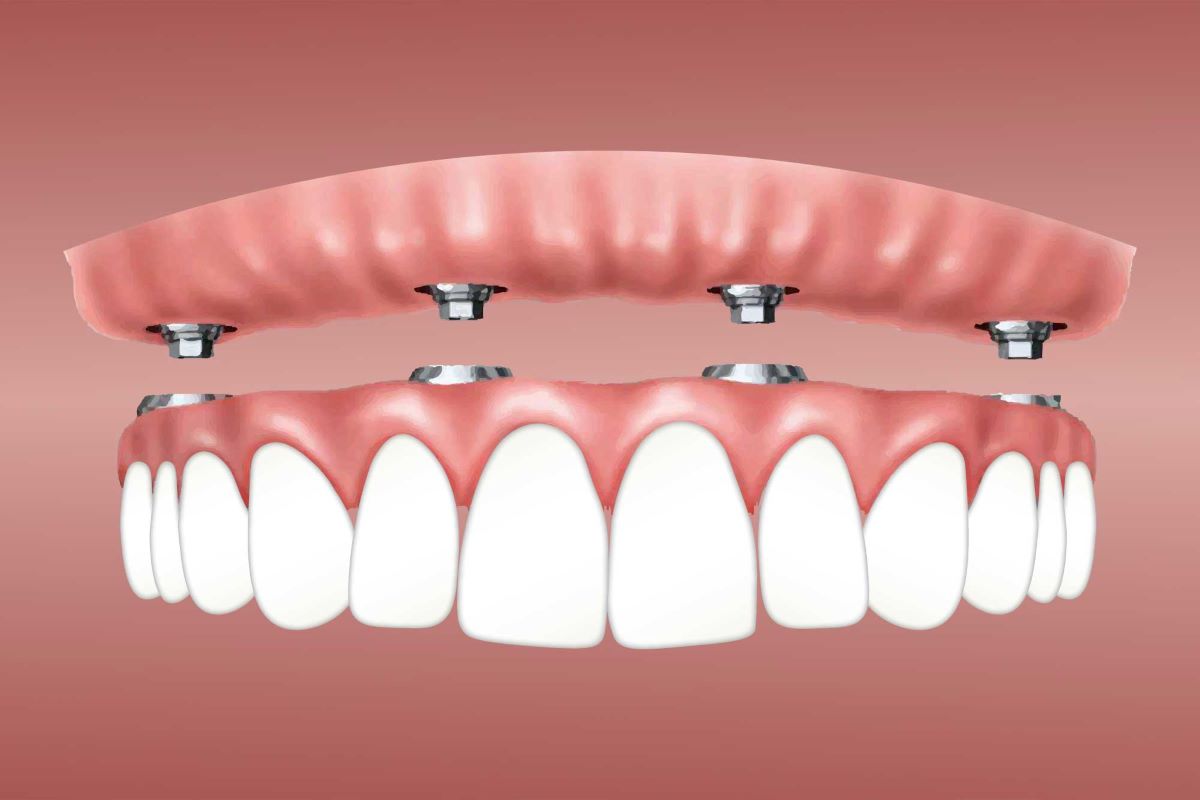A dental implant is a surgical implant that connects the jawbone or skull to dentures, usually crowns, bridges, dentures, or facial dentures. If a tooth is missing, a dental implant replaces the tooth’s root to secure the prosthesis (such as a crown) to the bone. Dental implant surgery requires different steps and different procedures over time to achieve results but can provide stable and long-lasting support for your restoration.
1. What are Dental Implants?
Dental implants are part of the field of restorative dentistry and implant dentistry. They are considered one of the best dental procedures in terms of longevity and effectiveness. A dental implant is a metal post that is used to replace the root of a missing tooth. It is considered perfect for people who want artificial teeth to function exactly like real teeth. Dental implants can help with tooth loss, but they can also fix some fitting problems that other restorations can cause. In addition, it can greatly improve dental aesthetics and quality of life. There are improvements in chewing, speech, and general health. You’ll get a perfect fit and tight, long-lasting support. Dental implants consist of three parts: retainers, abutments, and dentures.
Dental Implants Made Simple: Imagine your dental implant as a screw. Yes, this may seem rude and creepy, but it’s the best example we can give. Implants screw the external crown or bridge onto your bone, so it is stable and long-lasting.
2. What are the advantages of dental implants?
Dental implant surgery has become routine and is often recommended for patients missing one or more natural teeth. It is a safe, permanent, and long-lasting solution for dental care. Dental health is important, and if you’re wondering about dental implants, you’re probably wondering what the benefits are. Here they come:
- Solve the problem of tooth loss
- Ability to aid in chewing food
- Restoring the health of the bones and gums around missing teeth
- Improve overall quality of life
- Helps your smile look good
- This is a durable solution
- it is permanent
- Helps prevent jaw shrinkage due to bone loss
- Helps protect nearby teeth
- it is biocompatible
- Perfectly mimics your natural teeth
- No need for excessive dental care
3. What are the disadvantages of dental implants?
Implants don’t have many downsides. However, it is very important that the patient understands each part of the procedure. good and bad. So, what are the downsides? Here they come:
- Getting an implant requires one appointment, and it can take months to complete. (Check Chapter 3 for procedures)
- If you do not have enough bone mass and density, you may need bone augmentation (graft). It’s out of your control, it’s up to your body. Bone augmentation is becoming less painful and invasive, however, it is still a procedure that requires healing time.
- Dental implants are oral surgery, and even if they are completely safe, there are some risks and side effects. Check out Chapter 4 if you’re interested in this topic.
4. Who can get dental implants?
If you’re reading this, you’re probably considering dental implants. So, are you a candidate for dental implants? Let’s talk about this! You don’t need a million demands to get implants. How do you know if you’re a good candidate?
You can get dental implants if you :
- Missing at least one tooth (root and tooth)
- have jaws that have reached full growth
- Do not smoke (or you are willing to quit smoking for a few days in the process)
- have healthy oral tissue
- If you don’t want to wear removable dentures or can’t wear them
- Sufficient bone for safe implant surgery
- If You Don’t Have Enough Naturally You’ll Get Bone Grafts
- Be prepared to go through a long process (months)
- want to improve your chewing
- No medical condition that affects bone healing
- want to improve your life
- want to improve your aesthetic We talked about ideal candidates for implants. But who can’t get one? Well, if you:
- have uncontrolled and untreated diabetes
- have a blood clotting disorder
- have cancer or leukemia
- Weak immune system or diseases related to the immune system
- suffer from drug abuse
If you have one of these conditions and are unsure whether an implant is possible, please contact us. If you are a candidate, we can tell you, or recommend you different solutions depending on your needs.
5. Can I have dental implants while pregnant?
Yes, not at all. Pregnant women after the first trimester can have dental implant surgery. However, this procedure is best performed after pregnancy. Most dentists and oral surgeons recommend that you wait until after delivery. It is important to understand that every situation is different, so contact your dentist and ask for advice.
6. Can elderly patients be implanted?
Absolutely. To answer this question, we can give you some data. According to a study of 1.256 patients with an average age of 62 years, the implant survival rate was 92.9%. This means that elderly patients can receive implants if they have the same health status and bone structure characteristics as other patients. Also, this is a very good option since older patients tend to have more tooth loss.
7. Dental implants can be done at a young age?
We feel that these issues require in-depth explanation. In dental implants, it is very important that the bone grows fully. This means that theoretically, you should not have implant surgery before the age of 16-18. This is because it is difficult to calculate how the bones and jaws will grow. This is because they grow unevenly. It is multidirectional, in sagittal, transverse, and vertical directions.
Also, it enters a period of slow growth or no growth after a period of rapid growth. Planning implants requires a multidisciplinary approach to treatment planning, which makes it extremely difficult. Creating a growth plan requires taking x-rays months apart (6 months apart) to determine how much your jaw has grown. However, this cannot be 100% accurate. The planning process can begin about a year before a planned implant surgery.
We recommend that you consider alternative implants for your child’s dental health, or wait a few more years if they are approaching the age of 16-18.
8. Can dental implants still be done years after a tooth extraction?
Yes. It doesn’t matter how many months or years have passed since the extraction. It could be one month or ten years, it doesn’t matter. You can always fix this situation with dental implants. Timing is not an issue as long as you meet the criteria for dental implant surgery.
Theoretically, there is no clear limit to how many implants you can have in your mouth. You may have more than one implant placed during one dental visit. But you may need to wait between dental implant procedures to allow enough time for recovery. You may experience more postoperative pain and discomfort when you have multiple implants in place at the same time.
9. How many dental implants can you get?
How many dental implants you can or should have is up to you. When your dentist performs a preoperative medical evaluation, they will perform several scans. Also during the preoperative evaluation, your dentist will determine your bone strength and density. Whether you have enough bone to support implants or implants, is the most important factor in determining how many dental implants you can have.
If you have a healthy bone structure in your jaw to support your implants, you should have no problem getting the number of implants you want. If you don’t have bones strong enough to support an implant in your jaw, your dentist may recommend a treatment called bone grafting. This will help increase bone strength and density for implant surgery.
You may be wondering how many implants should be placed to restore function to your missing teeth. If you have a missing tooth, you can replace it with a dental implant in its place. If you have two adjacent teeth missing, you may need a dental implant to cover both teeth. Your dentist can place a two-unit restoration on top of the implant. If you have a lot of missing teeth, you can use the above method to cover multiple teeth with one implant.
Everyone is different and it is best to consult your dentist about the number of implants that are right for you.
10. Dental Implant Components: Three Components
Dental implants are the only procedure in dentistry that can act as the root of a tooth. To understand how this works, it is important to understand what dental implant components are. There are three of them: retainers, abutments, and dentures. Fixtures—similar to screws—are devices that act as roots. Dentures are dentures where the abutment connects the other two parts.
1) Jig
A retainer or implant post is a dental implant component that resembles a cylindrical screw placed in the jaw or skull. This part acts as an artificial tooth root inside the bone. It is perfectly designed to reconstruct the root, so it is tapered at the bottom. The clamp is available in different sizes and adapts perfectly to the jaw area. For example, if morals are missing, you’ll need larger fixtures. Longer implant posts are sometimes required when there is not enough bone stock for normal fixation.
An important factor to keep in mind is biocompatibility. Think about it, fixtures are external objects inserted into bones. Therefore, such dental implant components are made of titanium, usually coated with hydroxyapatite. It is a perfectly biocompatible material and at the same time very durable.
2) Base
The abutment is the connecting part between the dental implant fixture and the prosthetic part. A portion of the abutment is screwed into the fixture. Imagine a screw going into the abutment. The other side of the abutment adheres to the denture, which may be a crown, bridge, etc.
The type of abutment used for dental implants varies with the type of denture. For example, it may have attachments that clip onto dentures or just a spiral crown. Think of the abutment as the connecting part of a dental implant, between the inside and outside of the implant.
3) Denture
If the fixture is the “inner” part and the abutment is the “attachment” part of the implant, then the denture is the visible part. It is usually a crown, denture, or bridge. Crowns are preferred when only one tooth is missing. A bridge is for missing one, two, or more adjacent teeth. Dentures are recommended when you need your entire dental arch. Usually, crowns and bridges are set in place with cement. Dentures, on the other hand, snap into place. The type of restoration you choose will determine the number of implant fixtures required. Typically one crown, two or more bridges are required, and four to six are required for dentures.
11. What are dental implants made of?
Dental implants are made of different materials due to the different parts involved. And the jig—the part that goes into the bone—and the abutment—the part that connects—are mostly titanium. Dentures may come in different materials, usually zirconia, porcelain, metal-ceramic, etc. The materials used for dentures vary by type and preference.
12. What do dental implants look like?
Restorative work is the only visible part of a dental implant. This looks exactly like real teeth. The shape and size will be tailored to you, taking into account surrounding teeth and available space.
13. What does a dental implant feel like?
important question. how do you feel? An implant that replaces a tooth feels exactly like the tooth. You will not feel the implant itself in your gums and bone. Your prosthesis will also feel like it is a natural part of your mouth. However, you may experience some discomfort during the procedure and as it heals. Don’t worry, this is normal and just a temporary discomfort.
14. Can Dental Implants Whiten?
No, they cannot be whitened. The whitening process only works on natural tooth enamel. Implants, especially porcelain implants, are contamination-resistant prostheses. But they cannot be whitened like your natural teeth. It is best to whiten your teeth before implants. So you can easily avoid any color mismatch.
However, once you have your implants, you may not need to have them whitened. However, it is best to take care of them. After all, they have been with you for decades. Prolonged exposure to dyed substances is not good.
15. What is the History of Dental Implants?
You may think of dental implants as a new discovery and new technology. However, it is not. Adding a section on dental implants’ history would be both informative and interesting. We’ll start in 2500 BC – yes, you read that right! – Back to modern times. Have fun learning new things!
1) Dental implants from 2500 BC to 800 AD
The ancient Egyptians in 2500 BC spoke of toothaches and the use of gold ligatures to hold teeth in place in their manuscripts and texts. The Etruscans around 500 BC used gold welding rings to restore oral health and ox bones for dentures. Around AD 600, the Mayans got the first evidence of dental implants. They used shells instead of jaw teeth. When the Mayans took X-rays in the 70s, you could see bone formation around implants made of shells and bone. Later, around AD 800, the Hondurans used stone implants.
In 1931, Dr. Wilson Popenoe and his wife Dorothy Popenoe discovered a skull belonging to a young woman in Honduras. The lower arch of the skull is missing three teeth, replaced by shells that mimic the shape of the teeth. There are bone growths and stones, highlighting the function of these implants.
2) Dental implants from the 18th to the 20th centuries
Biocompatibility was the main problem with implants in the 18th century. Most implants are rejected by the body. Even a mixture of gold and alloys was unsuccessful. Even porcelain-platinum implants were unsuccessful. Without osseointegration—the “fusion” of the implant into the bone to become one—it is impossible to have a successful implant. This needs to be “accepted” by the body of the implanted part.
In the 1900s, doctors tried again with different materials. Dr. EJ Greenfield experimented with 24-karat gold. Then, two brothers, Dr. Alvin, and Moses Strock tried Vitallium after using it for hip implants. These implants were longer lasting and are considered the first truly successful dental implants in history.
3) Modern implants
In 1952, Dr. Per-Ingvar Brånemar, an orthopedic surgeon and research professor, implanted titanium into the femur of a rabbit. Later, when he tried to remove it, he found it impossible because it had fused into the bone. This led him to discover titanium’s biocompatibility with bone. He then theorized how titanium could be used in implants and dental implants.
So, in 1965, he successfully replaced a missing tooth with titanium, creating the modern titanium implant. Since then, titanium implants have been used in dentistry.








